
Captain Marvel: A Carol Danvers Primer
Who Is Carol Danvers?

2012 Captain Marvel redesign by Jamie McKelvie

During House of M, Carol briefly became Captain Marvel, one of the Earth’s most popular heroes. The experience inspired her to become “the best of the best.” Variant cover art by Terry Dodson and Rachel Dodson.
Where to Start
There are two great places to start reading Carol’s adventures: Brian Reed’s Ms. Marvel series (2006-2010) or Kelly Sue DeConnick’s two volumes of Captain Marvel (2012-2013, 2014-2015). While most people in recent years have been introduced to Carol through DeConnick, I would suggest starting with Reed, since you can then proceed directly into DeConnick’s run. But, you can also easily start with DeConnick and then work your way back to Reed later. (If you are already a member of the Carol Corps, then you’ve probably already read DeConnick’s run, making Reed’s the obvious next step.)
Before jumping in, though, a quick note on availability. Marvel has done a poor job of keeping many of Carol’s adventures in print, so you may have trouble finding print copies, depending on current availability. That said, digital is your friend! The vast majority of Carol’s adventures are now available digitally, especially if you are willing to switch back-and-forth between ComiXology and Marvel Unlimited.
Ms. Marvel vol 2 (2006-2010) by Brian Reed and various artists
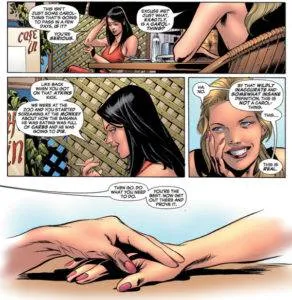
Not quite knowing how far to take something or when to say stop: totally a “Carol Thing.” Ms. Marvel vol 2 #1 (2006), art by Roberto De la Torre and Jimmy Palmiotti.

These aren’t the jokes you’re looking for. Ms. Marvel vol 2 #48, art by Sana Takeda.

My least favorite Carol Danvers cover of all time. Ms. Marvel vol 2 #29, cover by Greg Horn.
Fortunately, the Horn covers are not indicative of what’s inside the books. While there are a some particularly ill-advised panels scattered throughout the run, it doesn’t approach this level of cheesecake, and some of the artists—notably Sana Takeda, who drew most of the last dozen issues (including the Jedi mind trick panels above)—are quite good. If you can get past the covers, there’s a lot to love here. (That said, you might want to skip over the Puppet Master story in issues #18-20 if human trafficking and rape set off any alarm bells.)
I really love Reed’s Ms. Marvel. It isn’t perfect—especially the art for the first half of the series—but it is a very solid run that set up so much of what makes Carol great today. It is definitely worth reading, just ignore the covers and try not to judge Carol too harshly during Civil War.
Unfortunately, at the time of writing many of the trades are OOP and hard to find, so digital is probably your best best.
Captain Marvel volume 6 (2012-2013) and volume 7 (2014-2015) by Kelly Sue DeConnick and various artists
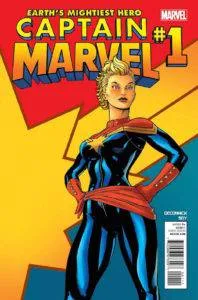
Captain Marvel vol 6 #1, cover by Ed McGuinness.
In 2012, Carol finally got the promotion to Captain Marvel, as well as a new costume designed by Jamie McKelvie and a new series written by Kelly Sue DeConnick, with Dexter Soy initially illustrating.
DeConnick started her run on Captain Marvel quite strong, bringing back some of Carol’s supporting cast that we hadn’t been seen since the ’70s and reexamining her origin as a superhero. She also had a fantastic scene where Carol talks to Monica Rambeau (the ’80s Captain Marvel) about taking the name without talking to her first, a great response/apology to the Monica Rambeau fans who felt like Marvel was erasing a woman of color in favor of a white blonde. After 17 issues, the series relaunched with a “Captain Marvel in space” status quo and with David Lopez on art.
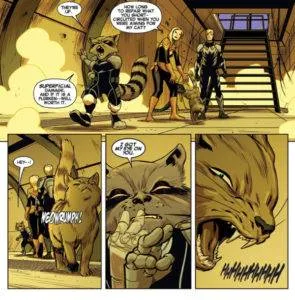
Lopez’s art is wonderfully expressive, even for the non-humanoid cast members. Captain Marvel vol 7 #2, art by David Lopez and Lee Loughridge.
I cannot understate how important DeConnick has been in bringing attention to Carol Danvers. DeConnick leveraged her social media mojo to create/encourage the Carol Corps, a group of real life fans who share their love of Carol Danver online and at conventions. Insofar as people today know who Carol Danvers is, it’s probably because of DeConnick (and we should not downplay DeConnick and the Carol Corps’ role in Marvel’s decision to make a Captain Marvel movie in the first place).
I enjoyed DeConnick’s run overall, and it had some fantastic emotional highs and lows—especially the last issues of each volume—but on a whole I like it slightly less than Reed’s (my main issue with DeConnick’s run centers on the aftermath of The Enemy Within). But, not everyone has loved her series, so if you start DeConnick’s run and don’t like it, you’re not an aberration. You might like something else with Carol more.
In addition to the original trades (now OOP and hard to find), DeConnick’s two volumes of Captain Marvel have been collected in four books under the title Captain Marvel: Earth’s Mightiest Hero. Each book collects about two trades worth of material, so they are a pretty great value. The two volumes, as well as the Secret Wars tie-in Captain Marvel and the Carol Corps, are also available on ComiXology, the Kindle Store, and Marvel Unlimited.
Advanced Studies
Once you’ve read through both Reed’s and DeConnick’s runs, you might want to delve deeper into Carol’s past. If you want to read everything, Peter Marinari has a fantastic reading order/collecting guide on his blog Crushing Krisis, but here are the highlights.
Captain Marvel volume 1 by Roy Thomas and Various Artists (1968-1969)
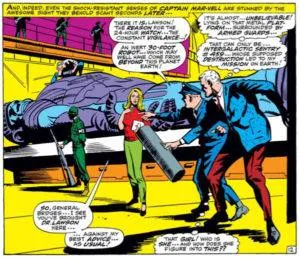
Even in her first appearance, Carol Danvers was a badass. Marvel Super-Heroes vol 1 #13, art by Gene Colan, Paul Reinman, and Stan Goldberg.
As mentioned above, Carol first appeared in Marvel’s first Captain Marvel series, where she was a supporting character through issue #18. She has a few good moments, but is not really the focus and this being a Silver Age comic, she inevitably gets damselled. I would recommend reading her first appearance in Marvel Super-Heroes #12 and #13, as well as her last regular appearance in Captain Marvel #18 (later retconned as the origin of her superpowers), all three of which are on Marvel Unlimited. If you love it, read the rest of Thomas’s run.
Ms. Marvel volume 1 by Chris Claremont, Gerry Conway and various artists (1977-1979)
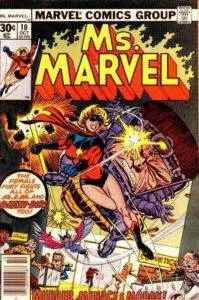
Ms. Marvel vol 1 #10, cover art by Sal Buscema, Tom Palmer, and Irv Watanabe.
Ms. Marvel volume 1 is fascinating, if deeply flawed. Gerry Conway wrote the first two issues, and they have every appearance of being rush jobs. (In fairness to Conway, he was credited as writer for nine comics the month Ms. Marvel #1 came out, though that probably was a sign he shouldn’t have taken the job in the first place.) Conway inexplicably turned Carol into a Gloria Steinem expy, with a job as editor of Woman magazine, published by none other than J. Jonah Jameson. Fortunately, Conway was promptly replaced by Chris Claremont, who had recently started writing the still-bimonthly and not-yet uncanny X-Men.
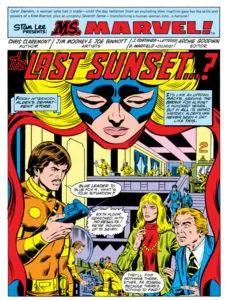
Words cannot express my love for the frame around this splash page from Ms. Marvel vol 1 #8, art by Jim Mooney, Joe Sinnott, and Don Warfield.
Claremont spent most of his first ten issues cleaning up Conway’s mess—revising the origin of Carol’s powers, eliminating her dual personalities, and giving Carol her own supporting cast—while the back half of the series was largely setting up for an epic Ms. Marvel/Mystique smackdown that never occurred due to cancellation.There’s some great late ’70s Claremont in there, but it’s hard to read without getting irritated that Marvel (a) didn’t assign the book to him in the first place and (b) cancelled it just before he was able to pay off months of foreshadowing.
The entire series has been collected in two Marvel Masterworks volumes, which can be quite pricey in print, but are much more affordable digitally. Volume 2 includes Avengers Annual #10 (see below), as well as Claremont’s stellar coda from Marvel Fanfare #24. Oddly, only the first and last issues are currently available on Marvel Unlimited, so you’re best going the ComiXology or Kindle Store route for now.
Avengers Annual #10 by Chris Claremont and Michael Golden (1981)
When Claremont read the notorious rape/pregnancy story in Avengers #200, he was rightly angered at Marvel’s treatment of Carol Danvers and wrote Avengers Annual #10 in response. There, Carol’s powers and memories are stolen by Rogue (in her first appearance). With help from Professor X of the X-Men, Carol recovers her memories, but not her emotional attachment to them. Claremont then gives Carol a chance to brutally take down the Avengers for their callousness before she goes off to live with the X-Men. The Brood Saga: Uncanny X-Men vol 1 #161-167 by Chris Claremont and David Cockrum (1982-1983)
Uncanny X-Men vol 1 #164, cover art by Dave Cockrum and Bob Wiacek.
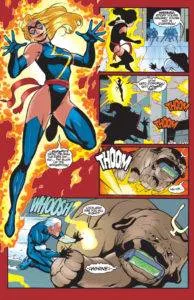
Go home, Carol, you’re drunk. Quicksilver #10, art by Derec Aucoin, Rich Faber, and Joe Rosas.







